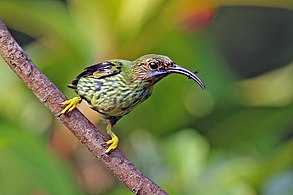Purple honeycreeper
| Purple honeycreeper | |
|---|---|

| |
| Adult male C. c. longirostris, Trinidad | |

| |
| Adult female C. c. longirostris, Trinidad | |
| Scientific classification | |
| Domain: | Eukaryota |
| Kingdom: | Animalia |
| Phylum: | Chordata |
| Class: | Aves |
| Order: | Passeriformes |
| Family: | Thraupidae |
| Genus: | Cyanerpes |
| Species: | C. caeruleus
|
| Binomial name | |
| Cyanerpes caeruleus | |

| |
| Synonyms | |
|
Certhia caerulea Linnaeus, 1758 | |
The purple honeycreeper (Cyanerpes caeruleus) is a small
Taxonomy
The purple honeycreeper was
Five subspecies are recognised:[6]
- C. c. chocoanus Hellmayr, 1920 – east Panama to west Ecuador
- C. c. caeruleus (Linnaeus, 1758) – central Colombia and Venezuela through the Guianas and north-central Brazil
- C. c. hellmayri Gyldenstolpe, 1945 – Potaro Highlands (Guyana)
- C. c. longirostris (Cabanis, 1851) – Trinidad
- C. c. microrhynchus (Berlepsch, 1884) – west, central Amazonia
Description
The purple honeycreeper is 4.5 in (11.5 cm) long, weighs 0.42 oz (12 g) and has a long black decurved bill. The male is purple with black wings, tail and belly, and bright yellow legs. Females and immatures have green upperparts, and green-streaked yellowish-buff underparts. The throat is cinnamon, and there is a blue moustachial stripe. The call of purple honeycreeper is a thin high-pitched zree. The Trinidadian subspecies C. c. longirostris has a longer bill than the mainland forms.
Distribution and habitat
The species is a bird of northern South America, and besides the
This is a forest
Behaviour and ecology
The purple honeycreeper is often found in small groups. It feeds on
Gallery
-
Juvenile male C. c. longirostris, Trinidad
-
Adult male atVienna Zoo, Austria, legs are pale in captive birds
-
Female at Diergaarde Blijdorp, Netherlands
References
- . Retrieved 12 November 2021.
- ^ Linnaeus, Carl (1758). Systema Naturae per regna tria naturae, secundum classes, ordines, genera, species, cum characteribus, differentiis, synonymis, locis (in Latin). Vol. 1 (10th ed.). Holmiae (Stockholm): Laurentii Salvii. pp. 118–119.
- ^ Paynter, Raymond A. Jr, ed. (1970). Check-List of Birds of the World. Vol. 13. Cambridge, Massachusetts: Museum of Comparative Zoology. p. 349.
- ^ Edwards, George (1743). A Natural History of Uncommon Birds. Vol. Part 1. London: Printed for the author at the College of Physicians. p. 21, Plate 21.
- JSTOR 4069264.
- ^ Rasmussen, Pamela, eds. (July 2020). "Tanagers and allies". IOC World Bird List Version 10.2. International Ornithologists' Union. Retrieved 26 November 2020.
- ISBN 978-1-4081-2501-4.
- ^ a b Salaman, P.G.W.; Stiles, F.G.; Bohórquez, C.I.; Álvarez-R., M.; Umaña, A.M.; Donegan, T.M.; Cuervo, A.M. (2002). "New and noteworthy bird records from the east slope of the Andes of Colombia". Caldasia. 24 (1): 157–189.
- ^ "Cyanerpes caeruleus (Purple Honeycreeper)" (PDF). Sta.uwi.edu. Retrieved 25 March 2022.
Further reading
- ffrench, Richard; O'Neill, John Patton & Eckelberry, Don R. (1991): A guide to the birds of Trinidad and Tobago (2nd edition). Comstock Publishing, Ithaca, N.Y.. ISBN 0-8014-9792-2
- Hilty, Steven L. (2003): Birds of Venezuela. ISBN 0-7136-6418-5
External links
- Purple Honeycreeper videos on the Internet Bird Collection
- Purple Honeycreeper photo gallery VIREO
- Photo-High Res—Green female-(Close-up); Article stevenrotsch Photo--(male)




